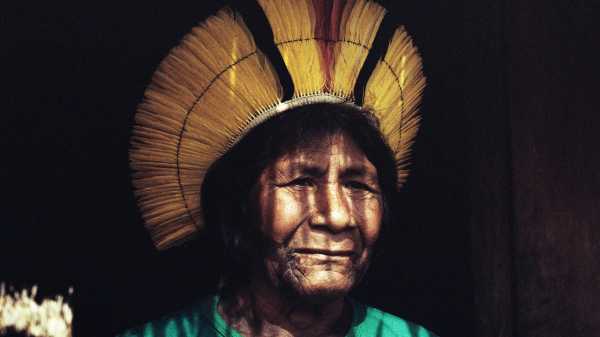
The Brazilian Amazon is riven by two long highways, in the shape of a cross: the BR-163, which extends more than four thousand miles from north to south, and the Trans-Amazonian, which runs twenty-four hundred miles from east to west. The roads were carved from the jungle in the nineteen-seventies, to open the wilderness to settlers and development. The effects have been calamitous. As colonists flooded in, the human population in Brazil’s Amazon has quadrupled, to nearly thirty million. The settlers have created a patchwork of new roads and towns, burning or cutting down millions of acres of forest to harvest timber or to clear land for cattle pasture or soybeans; they have polluted the rivers with mercury as they pan for gold. Since the highways were built, an estimated twenty per cent of the rain forest has been destroyed.
Not long ago, I travelled with the Brazilian photographer Larissa Zaidan from São Paulo to Novo Progresso, a prominent way station along the BR-163. The trip gave a sense of Brazil’s immensity: an hour and a half by plane to the agricultural hub of Sinop, then a ten-hour drive north. For much of the journey, the forest had been shoved back from the road, to make way for grain fields or cattle pasture. Trucks barrelled along, loaded with timber, livestock, and especially soy—the road is known as the Soy Highway. Many vehicles were decorated with green-and-yellow Brazilian flags, an expression of allegiance to Jair Bolsonaro, the country’s right-wing leader. Bolsonaro was defeated in the recent election by Luiz Inácio Lula da Silva, but his supporters, the Bolsonaristas, still regard him as an emblem of belligerent resistance to anything regarded as aligned with the left.
In office, Bolsonaro had promoted new laws to open up the region’s preserves to loggers, miners, and agribusiness, which inevitably meant burning more of the forest. As fires in the Amazon raged out of control, the smoke clouds were so thick that the skies above São Paulo, hundreds of miles away, became dark for several days. At one point, the French President, Emmanuel Macron, questioned Brazil’s sovereignty over a wilderness that all of humanity depended upon for survival. Bolsonaro reacted by making vulgar comments about Macron’s wife.
An area of the rain forest the size of Belgium was burned during Bolsonaro’s Presidency. Bolsonaro blamed the destruction, absurdly, on a series of foreigners. When I saw Lula in 2019, as he was beginning to ponder a run for office, he exclaimed, “Bolsonaro thinks it was Leonardo DiCaprio who set fire to the Amazon. He thinks it was European N.G.O.s that set fire to the Amazon. He thinks it was Venezuela that poured oil to pollute the beaches of the northeast. That is an insane mind.”
After Lula was reëlected, late last year, he appointed Marina Silva, a widely admired conservationist, as his environment minister. She had served in that role for five years during Lula’s earlier stint as President, but had resigned over his insistence on balancing conservation and development. (One of their disagreements was over the BR-163, which Lula began paving.) Now Lula had invited her back, promising to halt deforestation. After the election, Lula told me that he intended to fulfill his pledge. But he also expressed concern about how unstable the Amazon had become, and he mentioned the boomtown of Novo Progresso as a worrying case in point.
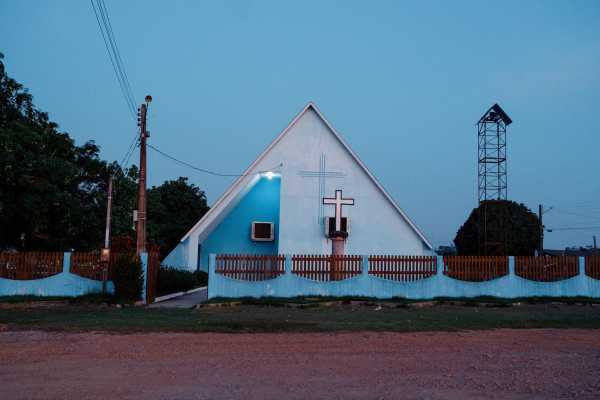
A church on the road to the frontier town of Novo Progresso. In recent decades, evangelical Christianity has boomed in Brazil, providing support to right-wing politicians.
Like many Amazonian frontier towns, Novo Progresso consisted of a roadside strip lined with businesses: truck stops, gold exchanges, hardware stores, bars, evangelical churches, a brothel. A grid of houses extended behind the shop fronts on either side, giving way eventually to bushland and cattle ranches. The jungle had been cleared away from the road for several miles.
This was Bolsonaro country. There were no Lula posters to be seen, but on the way to town we had passed a roadside camp of Bolsonaristas, hung with protest banners decrying the Supreme Court’s decision that Lula had won the election fairly, and calling for “Impeachment Now!” Zaidan and I had been warned to be discreet in Novo Progresso, where many residents were hostile toward journalists, and toward anyone connected with environmental causes. At our motel, the manager asked if we were reporters. We told him no—we were scouting locations for a guarana commercial. With a suspicious look, he replied that it seemed a long way to go to do that.
During Bolsonaro’s first year in office, ranchers around Novo Progresso had proclaimed a “Fire Day” and proceeded to torch the jungle. Like many others who live in the Amazon, they regard the region’s resources as an opportunity, not as a moral obligation. When Biden Administration officials sought to work with Bolsonaro’s government on conservation, the environment minister, Ricardo Salles, proposed instead that Brazil be paid not to burn its forests. (In 2021, Salles was forced to resign after police named him as a suspect in a timber-trafficking venture; he denies any involvement.) When I talked with Salles in São Paulo, he argued that Brazil should not have to sacrifice in order to benefit the rest of the world: “Rich countries are saying, ‘You have to continue to help me to solve the problem that I created. But now we’re going to split the bill.’ I say, ‘No, we’re not going to split the bill. You destroy, you pay.’ ”
In the Amazon, where pristine wilderness often sits alongside degraded land, the question of ownership is fiercely contested—especially where it concerns Indigenous people. Not far from Novo Progresso is the Baú Indigenous Reserve, which Lula created during his previous stint in office. The reserve, some 3.8 million acres of rain forest, is home to several communities of Kayapo—one of the Amazon’s main groups of Indigenous people, who began interacting regularly with settlers in the nineteen-fifties. About twenty-two per cent of the Amazon region now lies within protected reserves such as Baú, but in many places their forests and rivers have been overrun by loggers and gold miners. Bolsonaro vowed to demarcate “not a single millimetre” of Indigenous land during his Presidency, and he had kept his word.
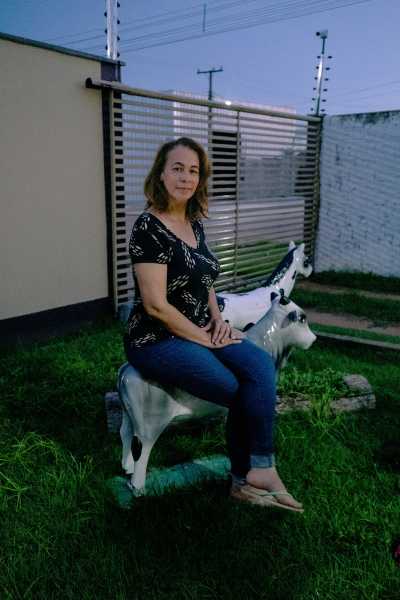
Dulce Sousa, a resident of Novo Progresso, agrees with the former President Jair Bolsonaro that local residents should be free to profit from the forest’s resources.
In Novo Progresso, a woman named Dulce Sousa broke with Bolsonarista protocol by inviting us to her house for coffee. Dulce lives on a residential street near the BR-163, in a modest house with a yard decorated by statues of a cow and a horse. A hale woman in her mid-forties, she ushered us into her kitchen. Her husband, a truck driver, was on the road, but her two teen-age sons wandered in and joined us.
Dulce was from a family of farmers that had come to Novo Progresso twenty years before, hoping to thrive in the newly opened frontier. They had acquired a large tract outside town, but during Lula’s earlier Presidency authorities had stopped them from planting it; it was near Indigenous territory, whose borders were unresolved. Since then, she said, her land had sat idle. Still, she said, she had respected the law, and had made a living instead as a teacher. For a time, she had taught at a Kayapo school in the Baú reserve.
Dulce, like Bolsonaro, insisted that the Indigenous people should be allowed to profit from the forest, even if it means abandoning their traditions. “For me, democracy means that they can choose what they want to do,” she said. “If they want to live from farming, that’s fine. If they want to live on agribusiness, why can’t they? Their perspective is, Why do I have to live in a forest with all these riches that they say exist but, for me to go to the market, I need to wait for my Bolsa Família”—a kind of welfare check—“or the next harvest? They have this desire. Even those who say they don’t have the desire have it. But there are people above them who oppress them.”
After the recent Presidential election, Dulce had joined a demonstration at the edge of town, where Bolsonaristas were blocking the highway—the same conflict that Lula had mentioned to me. She believed, like Bolsonaro, that Lula was a communist and a thief. “Who would vote for a thief?” she said. When I asked whether Bolsonaro was immune to corruption, she said that she didn’t particularly care if he won, as long as Lula lost: “Let the military take over the government.”
The rally had devolved into gunfire between the police and the Bolsonaristas. Dulce had a plastic bag of mementos, which she spilled onto the kitchen table: spent rubber bullets, tear-gas cannisters, brass shell casings. Among the protesters, she said, were Kayapo who supported mining and logging on the reserve. “Why were they there?” she asked. “Because they want to work, to learn from us, and to produce.”
Many of the region’s Indigenous activists rejected this idea. On Novo Progresso’s main strip, a Kayapo N.G.O. called Instituto Kabu maintained a walled compound, patrolled by an armed guard. When we arrived, we found a sturdily built man with a headdress of parrot feathers working on a laptop. He was Mydjere Mekrãgnotire, the organization’s vice-president. Mydjere, who also served as the coördinator of Indigenous education for Pará state, spoke urgently about a dire situation.
“More than four years ago, there was not much deforestation around Novo Progresso,” he said. “But after President Bolsonaro said that he was going to allow people to mine inside Indigenous lands, that he was going to allow Indigenous people to produce inside their reserves, and do agribusiness, that’s when the prospectors and loggers said, ‘Hey, he’s on our side, let’s invade.’ ”
During the most intense periods of clearing land, Mydjere told me, “You see smoke, burning everywhere.” He argued that Kayapo who coöperated with outsiders were being deceived. “The prospectors, the loggers go straight to the chiefs and make false promises,” he said. “They say that they are going to extract gold from the land and that the chiefs are going to get rich. ‘I will give you a truck,’ they say. And the chiefs end up falling into the trap. But, when they make these arrangements, only the chiefs benefit. The community does not.”
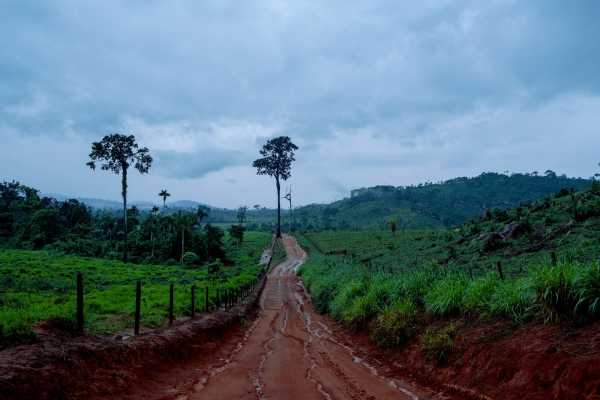
On the road from Novo Progresso to Baú Village.
The white settlers of Novo Progresso had a transactional interest in the Kayapo, Mydjere told me: “They say they are our friends, but, after they run out of all the gold and wood, they are no longer friends. In the city of Novo Progresso, they are not very friendly to us Indigenous people who defend the environment.”
A couple of months earlier, Mydjere said, the staff at Kabu had received an anonymous threat: leave town or die. For a time, everyone had been too frightened to go to the office, but eventually they had returned, and so far nothing more had happened. But, he added worriedly, the recent violent protest that Dulce Sousa mentioned had been organized by the same loggers, ranchers, prospectors, and businessmen who had been invading the Kayapo lands. “With this new government of Lula’s, he says that there will be no mining in the Indigenous land,” he said. “He says he will not allow deforestation for agribusiness. That’s why people don’t like him.”
While I was visiting Novo Progresso, Lula was in Egypt for the COP27 climate-change conference, where he met with Brazilian Indigenous leaders and vowed his total support. In mid-January, a few days after thousands of Bolsonaristas launched a riotous attack on the capital, Lula announced that an activist named Sônia Guajajara would serve as the leader of a newly created ministry for Indigenous peoples. Later, the two visited the territory of the Yanomami people, a huge reserve in the northern Amazon. During Bolsonaro’s tenure, twenty thousand gold prospectors—garimpeiros—had invaded, spreading disease and destruction. Lula called what was being done to the Yanomami a “genocide,” and vowed to clear out the miners. People in Novo Progresso took notice. It was the same conflict that had subsumed the Kayapo of the Baú reserve.
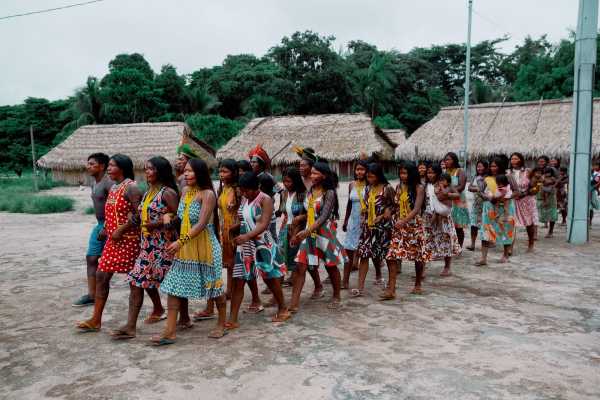
A welcome ritual performed by the Kayapo.
To reach the reserve’s main village from Novo Progresso, we drove three hours into the jungle by jeep, starting on a muddy track that leads off the BR-163 through cleared ranchlands. Here and there stood towering Brazil-nut trees, which are protected by law—often the only great trees left standing in the burned-out fields. Along the roadside, smoke rose from a fire as it ate into the edge of the forest.
As we drove, the devastation abruptly ended, and the forest grew thick: we were in the reserve. At a split in the muddy track, a handwritten sign indicated that Baú Village was to the left. To the right was the rival community, the one involved in gold mining.
Baú was organized in traditional Kayapo fashion, with communal family dwellings made of wood planks, set around a cleared circle. At the center was an open-sided meeting house with an earthen floor and wooden benches. A few dozen villagers assembled there, and Baú’s chief introduced herself: Panh-Ô, Mydjere’s sister. A strong-bodied woman in her forties, she wore a polka-dotted red dress, a beaded necklace, and a large red cross painted on her face. A man with a red stripe across his cheekbones introduced himself in Portuguese as Kremaiti, Panh-Ô’s husband; he would translate for his wife, who spoke only Kayapo.
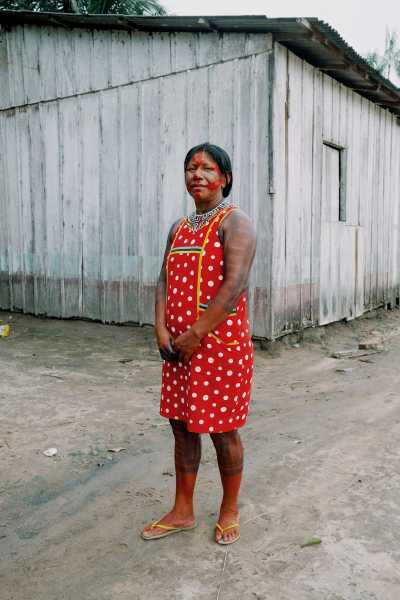
Panh-Ô, a Kayapo leader, describes strife between Indigenous people who want to protect the forest and those who want to extract its resources. “We’re in conflict now,” she says.
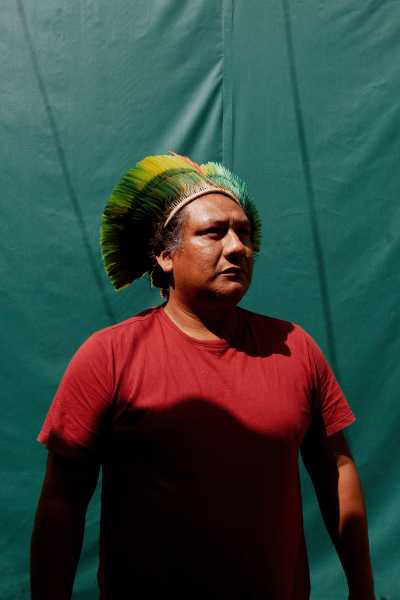
Mydjere Mekrãgnotire, of the Indigenous-rights group Instituto Kabu.
“Most of us here in Baú are against gold mining and logging, but some like it, and that has divided us,” he said. Bolsonaro’s discourse about opening the Indigenous reserves to extraction had seduced some people in his own community, and ultimately this had divided them. A few such Kayapo supported Bolsonaro, though Kremaiti couldn’t understand how. Bolsonaro, he pointed out, had spoken ill of Indigenous people and had even insulted their ancestral chief, Roani. (In an emblematic gesture, Lula invited Roani, an elderly man with a resplendent macaw-feather headdress, to the stage during his inauguration.)
Kremaiti said that the men of Baú had established a surveillance team to defend their forest. They had recently discovered prospectors in a remote area of the reservation, and had detained them and confiscated their equipment. “We’re providing an example to the other Indigenous people of Brazil,” he said. “We hope it shows them that our traditional way of life can continue.”
Panh-Ô seemed less confident about the future, noting that a British mining company had recently secured a government license to explore for gold just outside the Baú reserve. They had a Brazilian partner and had recently begun drilling. ”We can hear them, and feel the ground shake,” Panh-Ô said. “They say they are outside of Indigenous land, but I think they’re working inside.”
Even within the reserve, divisions festered over logging and mining. Panh-Ô said that the community had begun to split up in 2019, and there were now seven Kayapo villages in the preserve; of them, only Baú remained opposed to mining. “I’ve tried talking to them, but they want to carry on working with the garimpo,” she said. “I will continue to try to convince them. I want the river to be clean again. We have had some birth defects and problems with deformed infants, and we think it’s because they have contaminated the river water with mercury.” (One other village has since joined Instituto Kabu and agreed to stop mining.)
The nearest garimpo village was just beyond the tree line, a few minutes’ walk away. “The villages that work with the garimpo have stopped talking to us,” Panh-Ô said. “We’re in conflict now.”
Kremaiti’s entire family was in the other village, and his sister was angry at him: “She says I should come back over, build myself a house and work with them. But I want to live here and die here, this is the land I must fight for.”
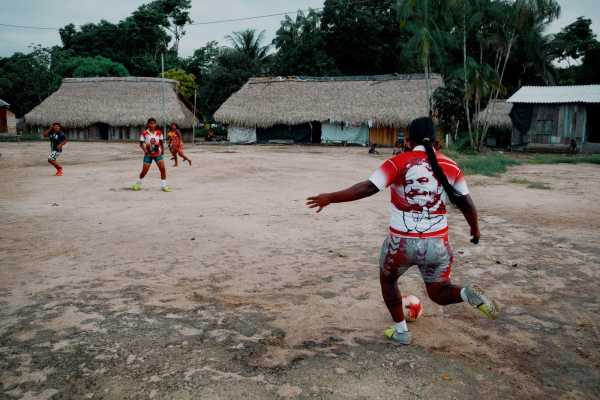
In Baú Village, the photographer Larissa Zaidan fell into the rhythms of daily life, spending time with a roving gang of young girls, with young men playing soccer, and with mothers and infants. For Zaidan, the camera is an adjunct to the experience. If the moment seems right for a photo, she takes it, but she is primarily there to share the moment.
While the battle carries on around Baú, the community busies itself with chores and pastimes. Women work at minding children, cooking, and washing clothes; young girls help out, or gather to talk and laugh. In the afternoon, many of the Kayapo go to the river to bathe, and teen-age boys play hotly contested games of soccer. In the evening, a generator is switched on, and everyone comes to charge their phones.
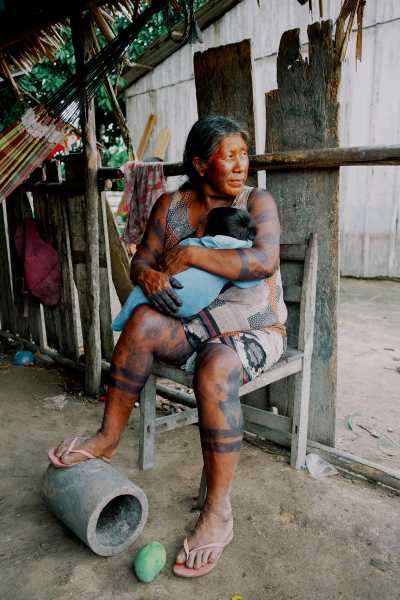
In Baú Village, Kayapo traditions sometimes conflict with the influence of settlers, many of whom have arrived only in the past few decades.
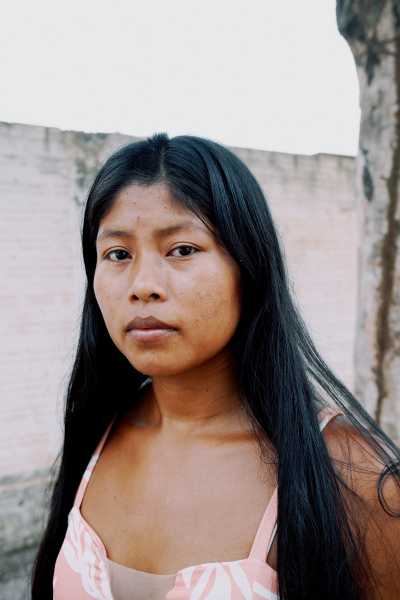
Rosimeire, a former resident, has left the village because she is dating a settler.
One morning during our visit, Baú’s young men went into the forest to plant yucca seedlings with a visiting environmental-affairs team; the program was intended to teach farming skills to the Kayapo. Other men were policing the rivers and the woods. Just beyond the circle of houses stood a small schoolhouse and clinic, staffed by a pair of state-funded teachers and a nurse. A stream of Kayapo women with infants visited the clinic for treatment. From his stoop, Atoroget, Baú’s pajé, or healer, observed village life in a peaceable-seeming state of semi-retirement, but he lamented that none of the youngsters seemed interested in the traditional arts of healing. “They just want to play ball,” he said. A teen-age nephew who was present protested, “That isn’t true! I want to learn.” Atoroget pretended not to hear him, but he smiled.
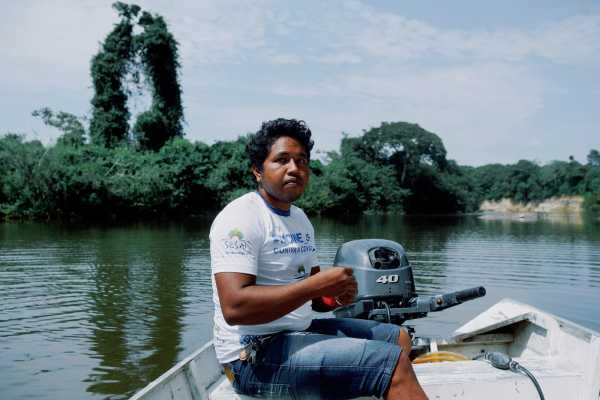
Near Kayapo communities that forbid gold mining, the river is clear. Where mining is permitted, the water is tainted by churned-up mud and mercury.
Panh-Ô wanted us to see the state of the river, and so the next morning we boarded a canoe equipped with an outboard engine. As we pulled out into the current, a Kayapo boatman pointed up the shoreline to the rival community, where a massive pile of dirt had been mounded up: tailings from the mines. We passed a sandbar that had been torn up in the search for gold; it looked like a bomb site. The river was red with mud churned up by the mining.
After an hour, another river joined the one we were on, and the boatman showed us that its waters were clear and pure. Not far upriver, a couple of young men from the rival village sat in a canoe in the shade of a tree. They had cast lines into the water, hoping to catch fish where the water was still clean. They stared at us. No one said a thing.
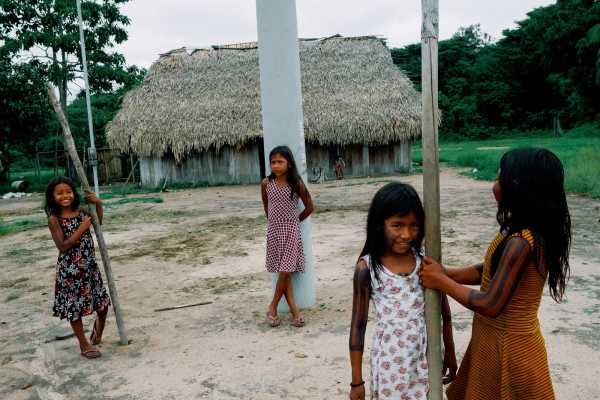
Kayapo children at play.
Sourse: newyorker.com






